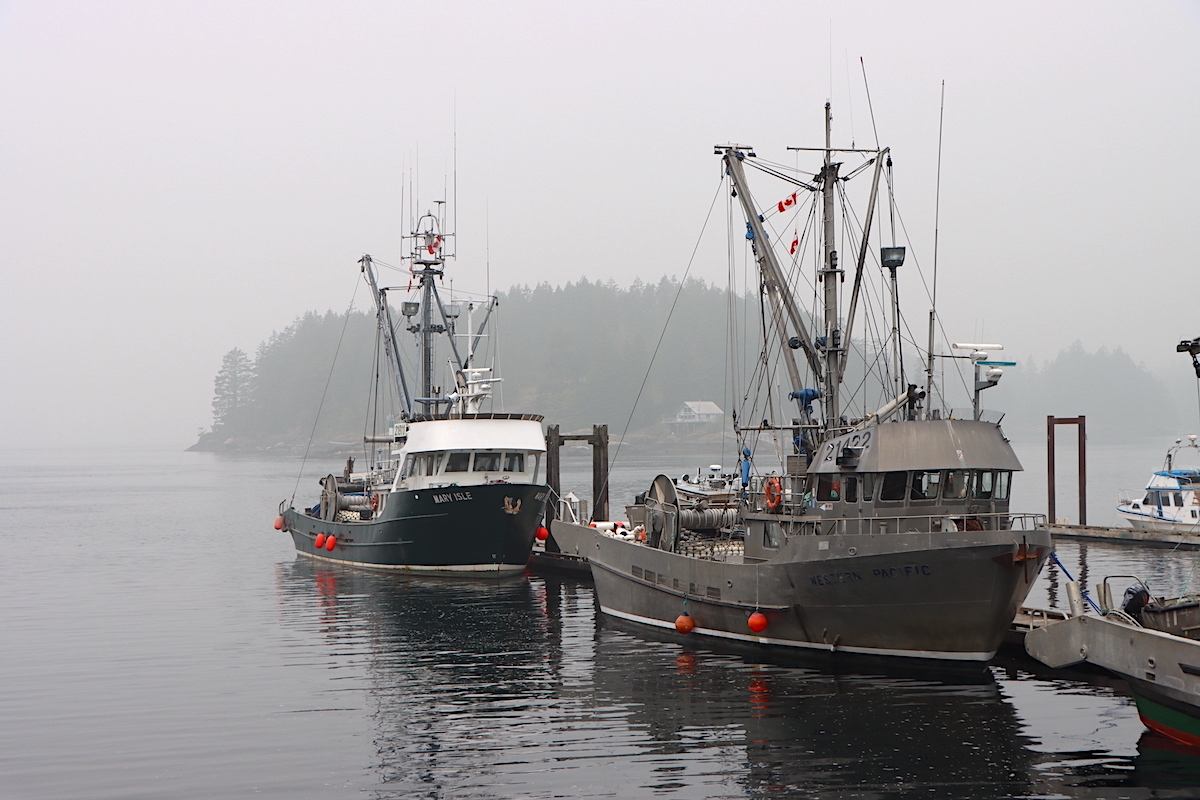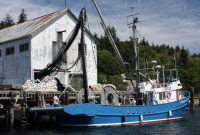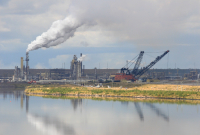Support strong Canadian climate journalism for 2025
The West Coast’s commercial salmon fleet is clearly in the midst of transformative change.
Ottawa has shuttered approximately 60 per cent of B.C.’s commercial salmon fisheries since 2021 and last month launched a licence buyback program to lure fish harvesters to exit the industry to protect plummeting salmon stocks.
What’s less evident is who will remain on the water with access to salmon as the federal government reshapes the industry that was once the backbone of the coast.
But many suspect large corporations and investors that never set boots on the deck of a fishing vessel will continue to prosper while independent harvesters and coastal communities languish.
A pattern of fishing licences and quota concentrated in the hands of large seafood processing companies is firmly entrenched in B.C., said Jim McIsaac, vice-president of the Canadian Independent Fish Harvesters' Federation.
If Fisheries and Oceans Canada (DFO) fails to make policy changes as the salmon licences and total catch decline, fishing wealth will continue to slip away to urban areas and those with lots of capital.
“Salmon, from my point of view, is a public resource and should be managed for the benefit of the Canadian public,” said McIsaac. “But DFO is privatizing the resource and managing it for the benefit of investors and processors.”
On the Atlantic Coast, commercial licence holders are required to be present on a vessel and actually fish their catch, he added.
But on the West Coast, many commercial licences and quota — a set share of the allowable catch — are transferable and can be bought, sold and leased like a commodity.
Demand and speculation push the purchase price beyond the reach of independent fish harvesters — especially young ones without deep pockets — leading to the rise of an “investor class” of corporations, investors or retired fishermen.
“Instead of moving to a more community-based local fishery, which a lot of fisheries around the planet are doing to make them more sustainable,” McIsaac said.
The licence buyback program will probably contract and concentrate the commercial seine fishery most immediately, said Joy Thorkelson of the United Fishermen and Allied Workers' Union.
Seine vessels tend to be larger than other types of fishing boats and use nets drawn together into a "purse" to capture fish.
The largest salmon fishery, the seine sector takes about 50 per cent of the total harvest and is already dominated by the province’s largest fish processor, Canfisco, part of the Jim Pattison Group, Thorkelson said.
Independent fish harvesters who can’t afford to buy a licence often lease one from processors that also act as brokers or hubs for other owners looking to “rent” their licence, she added.
This gives processors access to the catch and control over price, creating a monopoly effect, she said.
It also allows processors to concentrate the onshore industry, further draining fishing wealth from B.C. communities, she said, pointing to Canfisco closing its northern canneries and exporting that work to Alaska.
In 2019, the House of Commons committee on fisheries and oceans (FOPO), issued a report to the government centred on fisheries and equity issues on the Pacific Coast.
The committee urged Ottawa to increase the transparency around licence and quota ownership and restrict foreign investors’ access. It also called on the government to find ways for young fishers to enter the industry along with measurable mechanisms to ensure the socio-economic benefits of fishing are fairer, particularly for active harvesters and coastal communities.
But there’s been little real change by DFO over the last two years as the commercial salmon sector has been hobbled by the widespread closures, McIsaac said.
“I’ve been following developments around those recommendations pretty closely,” he said.
“At best, DFO has given them window dressing.”
Thorkelson predicts most of the licence buybacks will involve “low-hanging fruit”: inactive licences bought cheap or inherited by people not involved in the industry or harvesters who have recently retired due to ongoing declines in the commercial salmon sector.
DFO can’t predict who will remain on the water as the licence retirements are voluntary, the ministry said in an email to Canada’s National Observer.
“Those licence holders that wish to remain in the fishery will be able to do so,” DFO said.
The ministry didn’t clarify when, how or if equitable distribution of fishing benefits, including quota or licences, is part of the plan for the fishery once the buyback process is complete in three years’ time.
The retirement program is one element of a commitment to transform the salmon fishery and DFO will monitor how the number of licences changes during the process, the department said.
“DFO will continue to work with commercial fishery interests to determine other changes that will support the conservation and rebuilding of salmon stocks and a more adaptable and economically viable commercial fishery,” the email said.
Beyond limiting costs of retiring a licence, it’s not evident that DFO has any objectives or criteria around the number of licences it hopes to retire from each industry sector, such as large corporations, independent harvesters or First Nations, said University of Guelph researcher Jennifer Silver, a specialist in fisheries management.
“There’s less clarity … about other factors in the decision-making that relate to a larger vision for who retains access to the resource and what that might mean for coastal or Indigenous communities,” Silver said.
Ottawa also needs to consider any potential implications associated with a public resource such as a licence and quota being owned by foreign investors, Silver said, adding it’s extremely difficult to determine the level of investment at play.
In one instance, FOPO heard testimony from Ecotrust Canada, a non-profit focused on revitalizing coastal communities, that it had traced a foreign company that owned 5.9 million pounds of quota. According to the group, that company’s director was the same overseas investor identified in news articles involving money laundering in casinos and real estate in Vancouver.
Those against implementing owner-operator regulations in B.C. similar to those on the Atlantic coast suggest it would be akin to trying to unscramble an egg, Silver said.
But policy that improves the profits from fishing and also ensures benefits for harvesters and communities are not mutually exclusive, she said.
“Policy can be designed to achieve a little of both,” Silver said.
“I don't know if that mix has been achieved in the Pacific region to the same extent that it has been pursued and achieved in the Atlantic region.”
Rochelle Baker / Local Journalism Initiative / Canada’s National Observer






Comments
With an unfocussed mandate like this, it should be no surprise that DFO is not able to pay sufficient attention to solutions for BC's salmon fishery. Note also the assumption in the prose that passing legislation actually changes things on the ground - as effective as promises! Here is the DFO Mandate:
"To realize these objectives, I ask that you achieve results for Canadians by delivering the following commitments:
Work to support sustainable, stable, prosperous fisheries through the continued implementation of the modernized Fisheries Act, which restores lost protections, rebuilds fish populations and incorporates modern safeguards so that fish and fish habitats are protected for future generations and Canada’s fisheries can continue to grow the economy and sustain coastal communities.
Continue working with business, academic institutions, non-profits, provincial and territorial governments, and Indigenous partners to grow Canada’s ocean and freshwater economy and support the long-term sustainable growth of Canada’s fish and seafood sector, ensuring Canada is positioned to succeed in the fast-growing global ocean sectors of the blue economy and advancing reconciliation, conservation and climate objectives.
Work in close collaboration with provincial and territorial authorities, Indigenous partners, fishing and stewardship organizations and implicated communities to implement the Pacific Salmon Strategy and to make new investments and develop a conservation strategy to restore and rebuild wild Atlantic salmon populations and their habitats.
Continue to work with the Minister of Environment and Climate Change and partners to ensure Canada meets its goals to conserve 25 per cent of our lands and waters by 2025, and 30 per cent of each by 2030, working to halt and reverse nature loss by 2030 in Canada, achieve a full recovery for nature by 2050 and champion this goal internationally. You will ensure that this work remains grounded in science, Indigenous knowledge and local perspectives.
Continue to protect and restore our oceans and coasts by:
Renewing and expanding the Coastal Restoration Fund to restore aquatic habitats;
Expanding the Ghost Gear Program to continue efforts by fishers and others to clean up lost and abandoned fishing gear and ocean plastics;
Supporting community shoreline and oceans plastic cleanup efforts; and
In partnership with Indigenous Peoples, continue to implement commitments made under the Oceans Protection Plan, and support the Minister of Transport in launching the next phase of the Oceans Protection Plan to continue efforts to deliver world-leading marine safety systems, increase protection for marine species and ecosystems and create stronger partnerships with Indigenous and other coastal communities, while strengthening marine research and science.
Work with Indigenous partners to better integrate traditional knowledge into planning and policy decisions.
Advance consistent, sustainable and collaborative fisheries arrangements with Indigenous and non-Indigenous fish harvesters.
Make new investments in coastal and ocean areas that have a high potential to absorb and store carbon, like tidal wetlands, seagrass meadows and riparian habitats.
Modernize the Oceans Act to explicitly consider climate change impacts on marine ecosystems and species in regional ocean management, ensuring the Act provides for measurable progress indicators and objectives, and create a national, interdisciplinary working group focused on climate-resilient ocean conservation planning.
Expand climate vulnerability work to better inform marine conservation planning and management.
Continue to work with the province of British Columbia and Indigenous communities on a responsible plan to transition from open net-pen salmon farming in coastal British Columbia waters by 2025 and work to introduce Canada’s first-ever Aquaculture Act.
Continue working with the Minister of Public Services and Procurement, with the support of the Minister of Innovation, Science and Industry, to renew the Canadian Coast Guard fleet, advance the shipbuilding industry, including the process to add a third Canadian shipyard as a strategic partner to the National Shipbuilding Strategy, create middle class jobs and ensure Canada has the modern ships needed.
Continue to support improvement in Small Craft Harbours and work to ensure our investments in harbours are resulting in climate-resilient infrastructure that serves the needs of the fishing industry and local residents.
Work with the Minister of Public Safety, the President of the Queen’s Privy Council for Canada and Minister of Emergency Preparedness, the Minister of Transport and the Minister of Health, among other colleagues, to ensure the Government of Canada continues to be prepared to proactively mitigate, and respond to, emerging incidents and hazards.